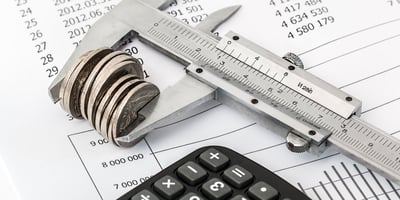Nebraska SBDC Blog
- UNO
- College of Business Administration
- Nebraska Business Development Center
- Nebraska SBDC Blog
- Additional Resources
- SBDC Blog
- Staff Directory
- NBDC News Center
Cost of Debt: How to Calculate Cost of Debt
Posted by NBDC Communications on Feb 08, 2021 05:01:15 PM

When you take out a loan (also known as debt capital), your primary focus is probably on having working capital to grow your business or steady your cash flow. But there’s something else to consider: your cost of debt.

If you’re just focusing on your loan’s monthly payment and not diving deeper to analyze the true cost you’re paying, you might be spending more than necessary on your debt financing.
What is Cost of Debt?
There are two types of capital a business can use: equity financing and debt equity. With equity financing, an investor — usually a venture capitalist or angel investor — provides working capital in exchange for a percentage of equity, or ownership in the company.
With debt equity, a company takes out financing, which could be an SBA loan, merchant cash advance, invoice financing, or any other type of financing. The loan is repaid, along with an interest expense, over months or years. The term debt equity could be confusing, but is basically referring to a loan.
Back to that cost of debt.
In simplified terms, cost of debt (or debt cost) is the interest expense you pay on any and all loans your business has taken out. If you have more than one loan, you’d add up the interest rate for each to determine your company’s cost for the debt.
How to Calculate Cost of Debt
Knowing your cost of debt can help you understand what you’re paying for the privilege of having fast access to cash. To calculate your total debt cost, add up all loans, balances on credit cards, and other financing tools your company has. Then, calculate the interest rate expense for each for the year and add those up. Next, divide your total interest by your total debt to get your cost of debt.
Cost of Debt Formula
There are a few ways to calculate your cost of debt, depending on whether you’re looking at it pre-tax or post-tax. If you want to know your pre-tax cost of debt, you use the above method and the following cost of debt formula:
Total interest / total debt = cost of debt
However, you can often realize tax savings if you have deductible interest expenses on your loans. That’s where calculating post-tax cost of debt comes in handy. To do so, you’ll need to know your effective tax rate.
Before we get to the formula, let’s look at another definition: weighted average cost of your debt. This refers to the total interest you are paying across all loans. To calculate your weighted average interest rate, multiply each loan times the interest rate you pay on it. For example:
– SBA loan: $100,000 * 5% =$5,000
– Business credit card: $5,000 * 22.5% = $1,125
– Merchant cash advance: $3,000 * 30% = $900
Then add those results together.
$5,000 + $1,125 + $90 = $7,025
Next, add up all your debts:
$100,000 + $5,000 + $3,000 = $108,000
To calculate the weighted average interest rate, divide your interest number by the total you owe.
$7,025/$108,000 = .065
6.5% is your weighted average interest rate.
Now, back to that formula for your cost of debt that includes any tax cost at your corporate tax rate.
Effective interest rate * (1 – tax rate)
The effective interest rate is your weighted average interest rate, as we calculated above. In the next section, we’ll look at examples using these formulas.
Cost of Debt Examples
As I said: there are two ways to calculate the cost of your loans, depending on whether you look at it as a pre- or post-tax cost.
1. Simple Cost of Debt
If you only want to know how much you’re paying in interest, use the simple formula.
Total interest / total debt = cost of debt
If you’re paying a total of $3,500 in interest across all your loans this year, and your total debt is $50,000, your simple cost of debt is 7%
$3,500 / $50,000 = 7%
2. Complex Cost of Debt
But let’s say you do care about how your cost of debt changes after taxes.
Effective interest rate * (1 – tax rate)
Let’s go back to that 6.5% we calculated as our weighted average interest rate for all loans. That’s the number we’ll plug into the effective interest rate slot.
Let’s say you have a 9% corporate tax rate. Here’s how your cost of debt formula would look.
6.5% (or .065) * (1-.09) = .591 or 5.9%
So after tax savings, your cost of debt is 5.9%.
How to Lower Your Cost of Debt
Let’s say you want to take out a loan that will allow you to write off $2,000 in interest for the year. If the cost of debt is less than that $2,000, the loan is a smart idea. But if it’s more, you might want to look at other options with lower interest cost. On the other hand, you might still decide to take out that loan, even if you spend more on interest than you save in tax deductions, if you need the money to grow your business.
So how can you lower your cost of debt? Start by choosing your financing carefully. The best business loans are those that offer low rates, but if your personal or business credit scores aren’t high, you may not qualify for those lower interest costs.
Work on building your credit scores by paying your bills on time and improving your debt utilization. If you have high interest payments on one or more loans, consider consolidating at a lower rate.
Cost of Debt vs. APR: What’s the Difference?
You may hear the term APR and think it’s the same thing as cost of debt, but it’s not quite. APR — or, annual percentage rate — refers to how much a loan or business credit cards will cost a debt holder over one year.
Cost of debt refers to the total interest expense a borrower will pay over the lifetime of the loan.
Nav’s Verdict: Cost of Debt
If your corporate capital structure includes long-term debt, it’s imperative that you know the true cost of your company’s debt. While taking out a business loan or using a credit card can keep cash flowing, it comes at a price. Ignore that number at your own peril.
Businesses that don’t pay attention to cost of debt often find themselves mired in loan payments they can’t afford. Know what the true cost of borrowing money is before you take out a loan and compare products and rates to get the best deal possible.
Printed with permission from ASBDC. For the original article, click here.
Posts by Tag
Contact Us
- Administrative Office
- 200 Mammel Hall
- 6708 Pine Street
- Omaha NE 68182
- 402.554.NBDC (6232)
- nbdc@unomaha.edu
- Consultant Directory